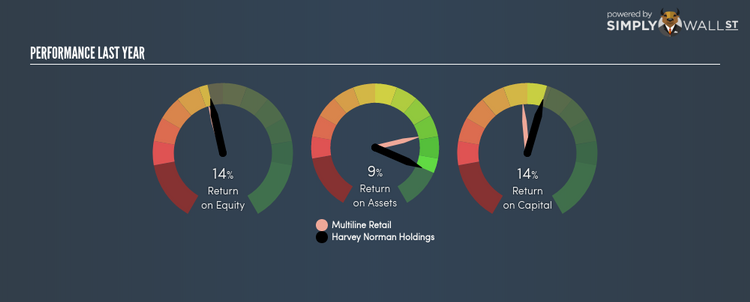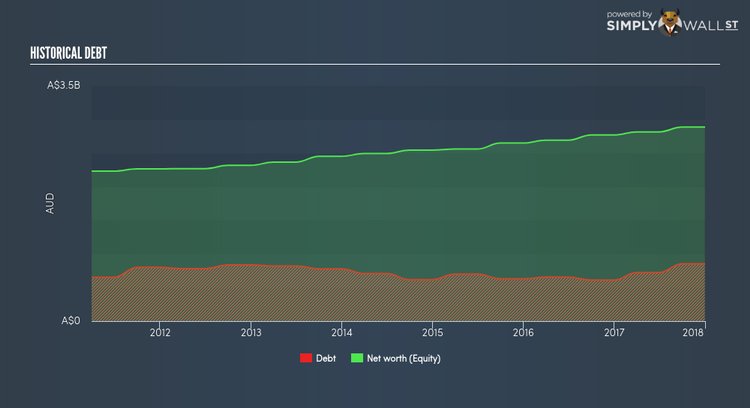Is Harvey Norman Holdings Limited’s (ASX:HVN) 13.97% ROE Strong Compared To Its Industry?

With an ROE of 13.97%, Harvey Norman Holdings Limited (ASX:HVN) outpaced its own industry which delivered a less exciting 13.33% over the past year. While the impressive ratio tells us that HVN has made significant profits from little equity capital, ROE doesn’t tell us if HVN has borrowed debt to make this happen. Today, we’ll take a closer look at some factors like financial leverage to see how sustainable HVN’s ROE is. See our latest analysis for Harvey Norman Holdings
Breaking down Return on Equity
Return on Equity (ROE) is a measure of Harvey Norman Holdings’s profit relative to its shareholders’ equity. An ROE of 13.97% implies A$0.14 returned on every A$1 invested. While a higher ROE is preferred in most cases, there are several other factors we should consider before drawing any conclusions.
Return on Equity = Net Profit ÷ Shareholders Equity
Returns are usually compared to costs to measure the efficiency of capital. Harvey Norman Holdings’s cost of equity is 8.55%. Since Harvey Norman Holdings’s return covers its cost in excess of 5.42%, its use of equity capital is efficient and likely to be sustainable. Simply put, Harvey Norman Holdings pays less for its capital than what it generates in return. ROE can be dissected into three distinct ratios: net profit margin, asset turnover, and financial leverage. This is called the Dupont Formula:
Dupont Formula
ROE = profit margin × asset turnover × financial leverage
ROE = (annual net profit ÷ sales) × (sales ÷ assets) × (assets ÷ shareholders’ equity)
ROE = annual net profit ÷ shareholders’ equity
Essentially, profit margin shows how much money the company makes after paying for all its expenses. Asset turnover reveals how much revenue can be generated from Harvey Norman Holdings’s asset base. Finally, financial leverage will be our main focus today. It shows how much of assets are funded by equity and can show how sustainable the company’s capital structure is. Since ROE can be artificially increased through excessive borrowing, we should check Harvey Norman Holdings’s historic debt-to-equity ratio. At 29.57%, Harvey Norman Holdings’s debt-to-equity ratio appears low and indicates the above-average ROE is generated from its capacity to increase profit without a large debt burden.
Next Steps:
ROE is a simple yet informative ratio, illustrating the various components that each measure the quality of the overall stock. Harvey Norman Holdings’s ROE is impressive relative to the industry average and also covers its cost of equity. ROE is not likely to be inflated by excessive debt funding, giving shareholders more conviction in the sustainability of high returns. ROE is a helpful signal, but it is definitely not sufficient on its own to make an investment decision.
For Harvey Norman Holdings, I’ve put together three essential aspects you should look at:
Financial Health: Does it have a healthy balance sheet? Take a look at our free balance sheet analysis with six simple checks on key factors like leverage and risk.
Valuation: What is Harvey Norman Holdings worth today? Is the stock undervalued, even when its growth outlook is factored into its intrinsic value? The intrinsic value infographic in our free research report helps visualize whether Harvey Norman Holdings is currently mispriced by the market.
Other High-Growth Alternatives : Are there other high-growth stocks you could be holding instead of Harvey Norman Holdings? Explore our interactive list of stocks with large growth potential to get an idea of what else is out there you may be missing!
To help readers see pass the short term volatility of the financial market, we aim to bring you a long-term focused research analysis purely driven by fundamental data. Note that our analysis does not factor in the latest price sensitive company announcements.
The author is an independent contributor and at the time of publication had no position in the stocks mentioned.


